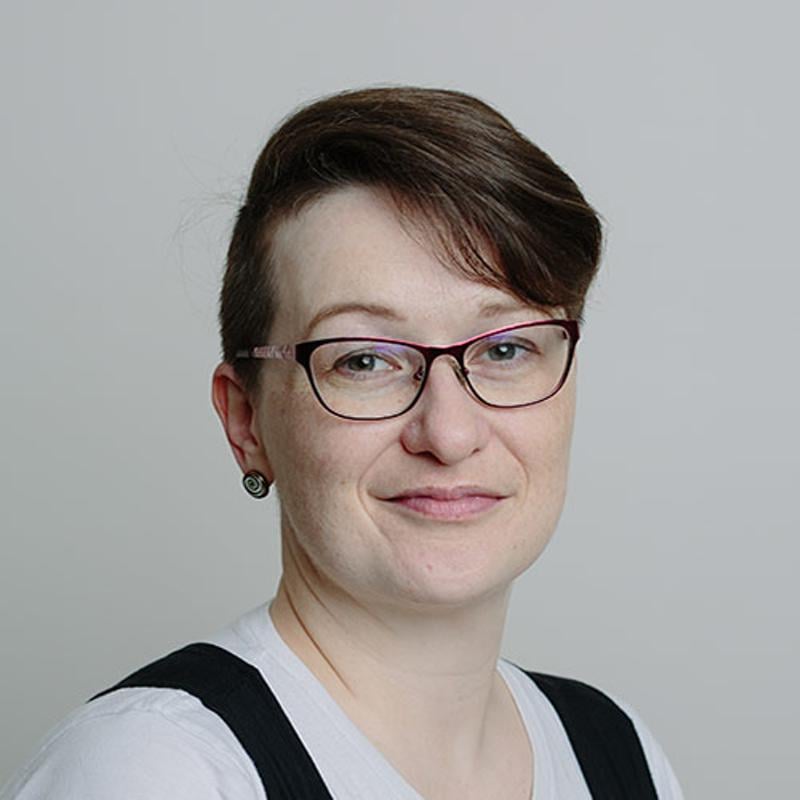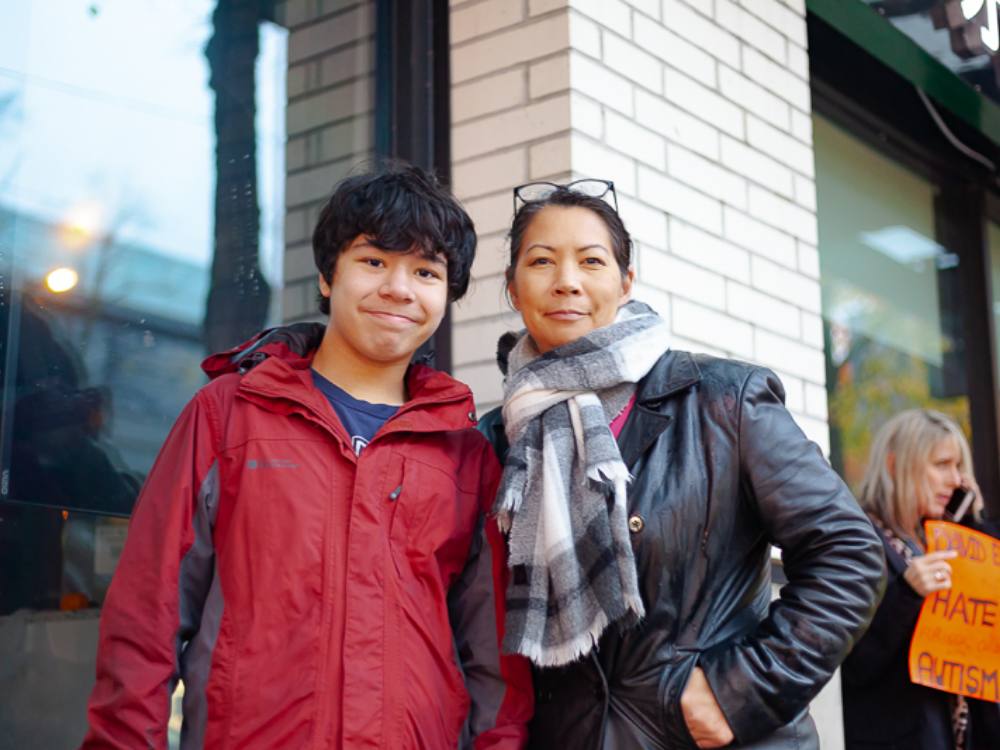“Hey hey! Hee hee! The NDP is hurting me!”
That was the chant coming from the two dozen parents, kids and allies demonstrating in the rain outside soon-to-be premier David Eby’s Kitsilano constituency office last Thursday evening. They were protesting the government’s plan for remaking child and youth disability support in B.C.
Oct. 27 marked one year to the day since the Ministry of Children and Family Development announced it was changing how it served B.C. kids with neurological disabilities including autism, fetal alcohol spectrum disorder and Down syndrome.
The government promises its changes will provide more disabled kids with support services. But the changes also mean clawing back individualized funding that the province currently provides to the families of autistic children and youth.
“We could not let the one-year anniversary just go. We had to do something,” said Jennifer Newby, a parent of two children on the autism spectrum who organized the protest. She referred to the planned changes as “unscientific and discriminatory.”
On Oct. 27, 2021, Children and Family Development Minister Mitzi Dean announced an overhaul of her ministry’s disabilities support program to address financial and waitlist-related barriers to receiving supports. Those include services like the disability diagnosis requirement, which can mean spending years on a waitlist for assessment by a school psychologist or shelling out thousands of dollars of families’ own money to pay for a private assessment, and the lack of support for kids and youth whose disabilities are not covered under the current model.
Under the new system, the province would open about 40 family connection centres or hubs across the province. They would be open to children and youth up to age 19, who could receive disability support services without a referral or diagnosis. The ministry contends this would end the years of languishing on waitlists for kids and youth who need support and whose families cannot afford to hire a private psychologist to diagnose them.
But children with autism who currently receive individualized provincial funding in order to hire their own service providers would see that funding clawed back starting in 2025.
Under the current funding structure, a child may only receive disability support from the province if they meet two criteria: they have a formal disability diagnosis provided by a medical professional — which kind depends on the disability — and they have been diagnosed with a disability for which the province provides funding.
The province does not provide funding for all diagnosable disabilities, such as fetal alcohol spectrum disorder, leaving some families without any support for their child’s disability. The proposed new hubs would serve all kids with neurological disabilities. But without a proper diagnosis families are concerned children wouldn’t reserve adequate support to meet their needs.
For example, children diagnosed with autism receive $22,000 annually up to age six and $6,000 annually until they turn 19. Parents hire service providers directly, allowing families to find services that meet their children’s individual needs.
These dollars are intended to cover the cost of receiving specialized supports from speech language pathologists, occupational therapists, behavioural consultants and physiotherapists, despite some autism programs costing over $40,000 annually. In-school support, which also requires a disability diagnosis, is provided separately by the Education Ministry.
But while children and youth can be diagnosed by a school psychologist, the assessment waitlist can be years long. Families have the option of shelling out thousands of dollars of their own money for a faster assessment by a private psychologist. But those who cannot afford it receive no ministry funding, services or support until a diagnosis is made.
In addition to the 30,000 children currently receiving ministry support, the ministry estimated they could serve another 8,300 children under its new system. The rollout is expected to begin with the opening of two hubs next year, one in B.C.’s northwest and one in the central Okanagan, with all hubs open by 2024.
Families of autistic kids and youth who receive individualized funding for their disability supports would see that individual funding put into the new family connection centre system starting in 2025, ending kids’ established relationships with their current service providers.
Many parents, including Newby, compare the family connection centre system to the Ontario government’s failed attempt to change autism support in 2019 by providing lump sums of cash to families on waitlists that did not take into account their children’s support needs. The province later scrapped the idea in the face of opposition.
“We know that no additional funds were allocated to this project,” Newby said to protesters over a megaphone about the province’s new connection centres. Kids with autism have a 70 per cent comorbidity rate, she noted, meaning they often have concurrent physical and neurological disability diagnoses.
“We’re talking about some of the most vulnerable children in the province being left out by the BC NDP,” she said.
BC Liberal MLAs Trevor Halford and Elenore Sturko were present on Thursday to support the protesters. Sturko spoke in favour of keeping the current funding model for kids with autism.
“It’s time for our premier-elect David Eby and the NDP to start listening to children and families with autism,” Sturko told the assembled crowd. “Put your money where your mouth is and restore individual funding for children with autism.”
Eby was invited to attend by protest organizers but did not show up.
But he did send The Tyee an emailed statement about the protest. “In this transition period I am being briefed on important issues facing children and families, including the family connections hub model. I look forward to working with families, Indigenous communities, my colleagues and service providers to ensure families in B.C. have the supports and services they need.”
The Tyee also reached out to Minister Dean’s office, which also sent an emailed statement acknowledging the protesters’ concerns, while also emphasizing the plan to help meet the needs of disabled children underserved by the current system.
“We recognize some families and Indigenous communities have raised concerns about the new model, and we take these concerns seriously,” the statement read.
“We continue to engage and meet regularly with families, service providers, Indigenous peoples and communities. We are committed to listening to these groups along with the Representative for Children and Youth in order to work together to build a system that supports all families of children and youth with support needs in B.C.”
Rozann Pedersen was at Thursday’s protest to speak out in favour of the current model of funding supports for her two kids, 11 and 13, who are autistic.
“They are doing well because they have a home therapy program led by a behaviour consultant and behaviour interventionist,” Pedersen said.
If the family connection centre model goes ahead, the next generation of autistic kids won’t have the same benefits her children did, she said. Until 1981 children and adults with developmental disabilities were institutionalized in British Columbia. The last residents left Woodlands, the final institution standing at the time, in 1996.
A survey of autism service providers released last month by Simon Fraser University found 75 per cent have no confidence in the new model’s ability to support autistic children, noting service providers operating in family connection centre hubs would receive less than 50 per cent of their current hourly rate.
They are not alone in their criticism. Last month the Union of British Columbia Indian Chiefs, First Nations Summit, the Representative for Children and Youth, the British Columbia Assembly of First Nations, autism researchers and organizations, as well as parents of kids with neurological disabilities, put out a press release criticizing the new model.
Their objections included the lack of new funding announced to support transition in the 2022 provincial budget; no attempt to improve diagnosis delays; insufficient community consultation; lack of evidence of benefits of this move to children; and creating barriers to Indigenous children receiving services by putting it in the hands of MCFD workers, given the breakdown of trust within some Indigenous communities and the ministry over the overrepresentation of Indigenous families in child welfare cases.
“We all agree that the current system of supports for children and youth with disabilities is broken; however, anything replacing it must be evidence-based and fully costed out,” reads a quote from Kukpi7 Judy Wilson, secretary treasurer of the Union of British Columbia Indian Chiefs, in the release.
Instead of the family connection centre model, Newby would like to see disability support moved under the Health Ministry.
“Medically necessary treatment needs to be under the Ministry of Health. I should not have to go to a social worker and beg and do my homework to get my kids their medically necessary treatment,” she said.
“If [Eby] lacks the courage to move us under the Ministry of Health where we belong, then he needs to expand the individualized funding to all the other kids with disability diagnosis who do deserve support and are not yet getting it.”
If nothing changes, she added, the government should be prepared for families of autistic kids to take them to court.
“They better prepare for a lawsuit, because we are going to do it,” she said, citing past court decisions that have taken the B.C. government to task for failure to support kids with disabilities.
“Parents are not going to back down from this.” ![]()
Read more: Health, Rights + Justice, BC Politics
















Tyee Commenting Guidelines
Comments that violate guidelines risk being deleted, and violations may result in a temporary or permanent user ban. Maintain the spirit of good conversation to stay in the discussion.
*Please note The Tyee is not a forum for spreading misinformation about COVID-19, denying its existence or minimizing its risk to public health.
Do:
Do not: